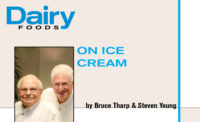Large companies will be required to list “added sugars” on their Nutrition Facts panels by the end of this year. So the race is on to lower both total and added sugar while optimizing flavor.
Cane sugar and natural high-intensity sweeteners are replacing high-fructose corn syrup and artificial sweeteners in many dairy products. Yet some of the best tools to reduce sugar in the dairy formulator’s toolbox are innovative dairy ingredients.
Sugar scrutiny by product
The 2018 International Food Information Council study revealed that 33% of consumers link sugars to weight gain. Roughly 50% of respondents were avoiding soft drinks and candy to reduce sugar in their diets, while 25% were cutting back on ice cream and frozen yogurt. Only 5% were avoiding yogurt, and only 4% were cutting back on milk or other dairy products as a strategy to reduce sugar consumption.
Cargill conducted its own survey in 2018 — of worldwide grocery shoppers.
“Among U.S. consumers, dairy alternatives tend to see the most label scrutiny, with 46% of respondents noting that they are extremely likely to check the amount of sugar,” said Pam Stauffer, global marketing programs manager, Cargill.
Creating an indulgent product with less sugar is a recipe for success on the dairy side. Halo Top combined milk protein concentrate, erythritol and stevia to create the best-selling pint of ice cream in 2017.
Reducing total sugar is also important in protein beverages. Bolthouse Farms recently introduced a chocolate-flavored protein drink sweetened with cane sugar and monk fruit juice that delivers 70% less sugar than leading refrigerated protein drinks.
Ultrafiltered milk and milk protein concentrates (MPCs) were developed to increase the protein content of end products, but they also facilitate sugar reduction. Nonfat dry milk contains roughly 50% lactose, while MPC85 contains a maximum of 8% lactose.
Lactose is often hydrolyzed to combat intolerance issues, but hydrolyzing lactose also increases sweetness, allowing for less total sugar in flavored milk and dairy beverages. Fairlife milk uses this strategy. Relative to sucrose, lactose has a sweetness of 16, but its two component sugars, glucose and galactose, are both much sweeter, at 74 and 32, respectively.
“Technological advancements allow manufacturers to convert lactose into beneficial compounds like lactitol, lactulose, galacto-oligosaccharide, epilactose and tagatose. Lactitol is an approved food additive which is widely used in low-calorie formulations to reduce total sugar in bakery, chocolate, confectionery, chewing gum and desserts such as ice cream,” said Sonia Patel, dairy food application scientist at the University of Minnesota.
‘Added sugar’ on labels
The November 2018 FDA industry guidance on added sugars, https://tinyurl.com/y4jrl4qs, clarifies that: “The sugars in dairy ingredients, except lactose (the purified ingredient as defined in 21 CFR 168.122), are not included in the definition of added sugars.” Also, “hydrolysis of lactose (in dairy products) … does not change the declarations for total sugars or added sugars for the product.”
This is great news for dairy ingredients.




